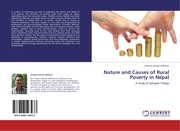Detailansicht
Nature and Causes of Rural Poverty in Nepal
A study of Salupati Village
ISBN/EAN: 9783846523933
Umbreit-Nr.: 1298761
Sprache:
Englisch
Umfang: 96 S.
Format in cm: 0.6 x 22 x 15
Einband:
kartoniertes Buch
Erschienen am 14.10.2011
Auflage: 1/2011
- Zusatztext
- A number of indicators are used in explaining the extent and depth of rural poverty. The definition of poverty varies from region to region depending upon their economic status. Similarly various models have been adopted by planners and policy makers to define poverty. Poverty refers to the condition of having little or no wealth, relative lack of money or material possessions. The poor people in rural areas are characterized by landlessness, too little land,larger family, malnutrition, ill health, illiteracy, high infant mortality, Low life expectancy, low and irregular income, weak position, isolation due to poor communication, focus on survival and indebtedness. Generally most of the rural people have their economy below subsistence level. They have little access to political power and little say in decision making. The five major characteristics of poor people can be identified as powerlessness, isolation, poverty, Physical weakness and vulnerability. Similarly sound governance and local leadership, investment in people, tapping local resources, attracting trade and investment and attacking poverty through productivity are the better strategies for rural development.
- Autorenportrait
- Mr. Krishna Raman Adhikari,an advocate from Ramechhap, Nepal is a well established development practitioner and human rights defender. Mr. Adhikari has been engaged in research and advocacy in poverty, human rights and Pro-poor development. He is a regular writer on human rights, development and poverty for National and International publications.
